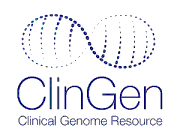The ClinGen Evidence Repository is an FDA-recognized human genetic variant database containing expert-curated assertions regarding variants' pathogenicity and supporting evidence summaries.
[Disclaimer]
- Gene obtained from curated document aligns with the Allele Registry but not with ClinVar data
- No CSPEC computed assertion could be determined for this classification!
Variant: NM_004360.5(CDH1):c.1565+1G>A
- Curation Version - 2.0
- Curation History
- JSON LD for Version 2.0
CA288040
127915 (ClinVar)
Gene: CDH1
Condition: CDH1-related diffuse gastric and lobular breast cancer
Inheritance Mode: Autosomal dominant inheritance
UUID: 3d5bfeed-bb3f-464f-8dd0-b78a9395290e
Approved on: 2023-08-25
Published on: 2023-08-25
HGVS expressions
NM_004360.5:c.1565+1G>A
NM_004360.5(CDH1):c.1565+1G>A
NC_000016.10:g.68815760G>A
CM000678.2:g.68815760G>A
NC_000016.9:g.68849663G>A
CM000678.1:g.68849663G>A
NC_000016.8:g.67407164G>A
NG_008021.1:g.83469G>A
ENST00000261769.10:c.1565+1G>A
ENST00000261769.9:c.1565+1G>A
ENST00000422392.6:c.1382+1G>A
ENST00000562836.5:n.1636+1G>A
ENST00000566510.5:c.*231+1G>A
ENST00000566612.5:c.1565+1G>A
ENST00000611625.4:c.1628+1G>A
ENST00000612417.4:c.1565+1G>A
ENST00000621016.4:c.1565+1G>A
NM_004360.3:c.1565+1G>A
NM_001317184.1:c.1382+1G>A
NM_001317185.1:c.17+1G>A
NM_001317186.1:c.-255+1G>A
NM_004360.4:c.1565+1G>A
NM_001317184.2:c.1382+1G>A
NM_001317185.2:c.17+1G>A
NM_001317186.2:c.-255+1G>A
More
Evidence submitted by expert panel
The information on this website is not intended for direct diagnostic use or medical decision-making without review by a genetics professional. Individuals should not change their health behavior solely on the basis of information contained on this website. If you have questions about the information contained on this website, please see a health care professional.
